That's right - our friendly fenceline neighbors back up to miles of public lands that protect & serve Yosemite, but rarely show on anyone's radar (unless there's a fire). And while that makes for some beautiful & peaceful living, it also makes for some interesting guests - because we're all on the edge of the wild, in the cross-over zone where big animals still have ranges & territories. And because, of course, these beasties think the same about human comings & goings, as we do about theirs... "sniff sniff... hmmm... we have interesting guests today..."
First, a bit about territories & ranges. Most large wild animals in the Sierra Nevada are transient, meaning they don't normally have formal dens, but roam well-established circuits as they hunt & forage their territories. Some also do both - staying away from the den for a night or two now-and-then (I think they call this "what happens in Vegas stays in Vegas" foraging).
Typical territory & range sizes of large Sierra mammals & ground birds:
| Animal | Lifestyle | Territory / Range Size |
| Mountain Lion / Cougar Puma concolor | transient | 10-100 square miles |
| Black Bear Ursus americanus | transient | 2-40 square miles |
| Coyote Canis latrans | den & transient | up to 4 miles from den; 20-50 square miles |
| Bobcat Lynx rufus | den & transient | up to 2 miles from den; 4-12 square miles |
| Wild Turkey Meleagris gallopavo | transient | 1-10 square miles (or 1 flask) |
| Gray Fox Urocyon cinereoargenteus | den | up to 1 mile from den; 1-3 square miles |
| Mule Deer Odocoileus hemionus | transient | less than 1 mile diameter area (20 deer per square mile) |
| Black-tailed Jackrabbit Lepus californicus | transient | less than 0.25 mile diameter area (~40 acres) |
| California Quail Callipepla californica | transient | 3-50 acres (a bird per acre is typical) |
Notes on territory & range sizes:
Range is obviously heavily affected by seasonal water & food availability, competition and mobility (droughts, deep snow, thick brush, dangerous predators...).
Males of solo-living species (cougar, bobcat, bear, some coyotes) usually have larger territories than females and will often overlap with several females (but rarely other males).
Many animals have cycles of gathering and separation that affect their range. Quail break into pairs during Spring mating, Wild Turkeys congregate for Winter (but male & female groups stay apart), and Mule Deer does and bucks unify for mating, and hang around together through Winter and Spring. The bucks seem to take off as soon as the fawns are born. Ouch. It reduces foraging pressure on the plants where the does and fawns live though - i.e., there's more for them.
Maturing young (especially females) are often allowed to reside in a parent's territory for a while after being weaned/taught/fledged. Like college grads that haven't been able to find a job. :)
Territories of animals aren't usually square/circular. They typically run along riverbeds and forested areas, so when you read "40 square miles," visualize an area that's more like 4 miles wide and 10 miles long over an area 6 miles by 7 miles. Exception: animals with permanent or semi-permanent dens will range more radially if trails/paths allow.
====
Fenceline Survey #1: Camera Trap at Bottom of Fenceline Hill
For our first formal fenceline survey I set the trail camera at the bottom of a steep uphill path that runs through manzanita along our south fenceline. The trail ends at the east fenceline, near the SE corner of the property. East leads up the western Sierra foothills, and towards Yosemite. Tracks and scat suggest animals take the hill to/from the eastern fence, but also use this spot to cross the south fence. So, I tried to set the trap to capture both options.
The camera was there for 38 days. Here's the major pictorial highlights in chron order. One aspect beside the critters that's fun to check out - the change in the background flora.
Camera POV: the camera is facing west, at the bottom of the fenceline hill. I.e., the hill is behind the camera, so animals coming towards the camera are going uphill to the east fence, and animals going away from the camera (butts) are coming down from that fence. The south fence crossing spot is just off the left side of the photo frame, so animals coming or going that way will have left leaning movement in the camera POV. The trail/washout on the right that goes around the manzanita leads into the heart of the property.
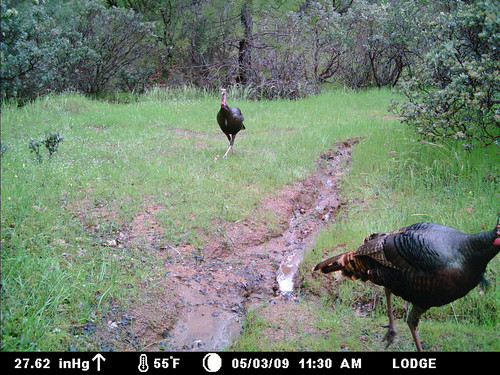
Male Wild Turkeys - 5/3 11:30am
Wet and green and grasses are still low...
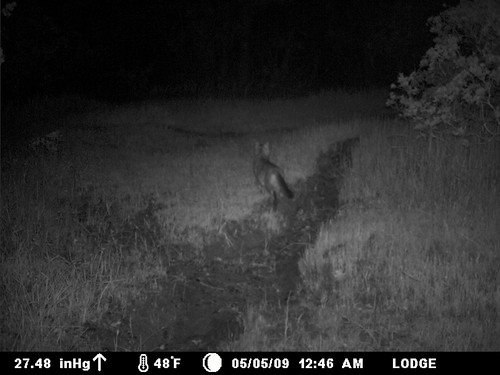
House Cat - 5/5 12:46am
Be careful little one!
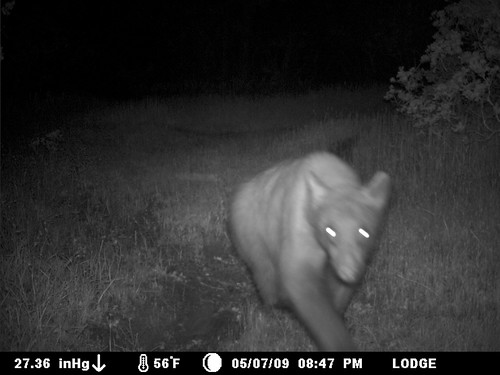
Bear - 5/7 8:47pm
Well hello! We haven't seen you since Autumn!
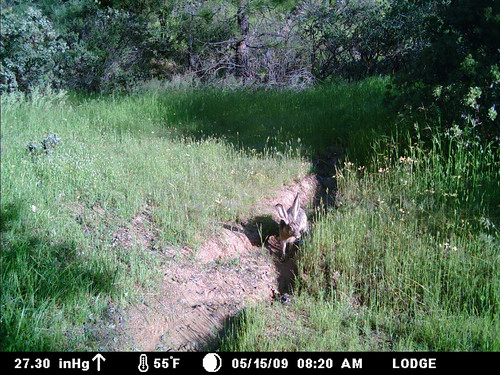
Black-tailed Jackrabbit - 5/15 8:20am
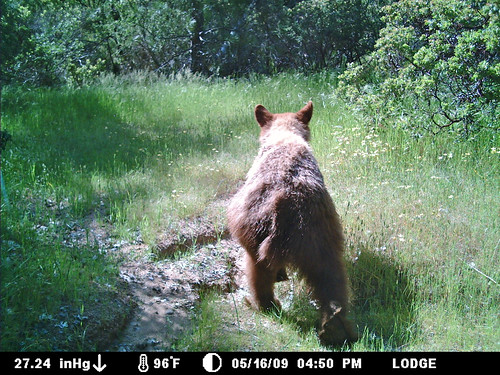
Bear - 5/16 4:50pm
Wow - cinnamon colored! Same bear from 5/7 but fatter, or different bear?
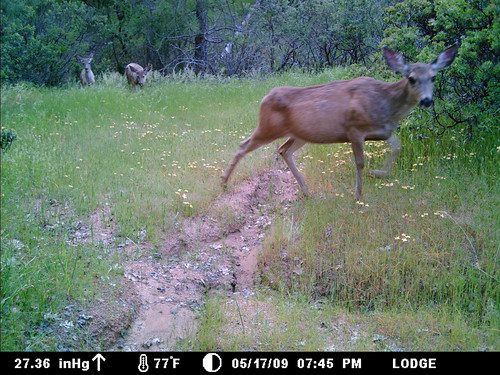
Doe Deer - 5/17 7:45pm
Love all the yellow Pretty Face lilies!
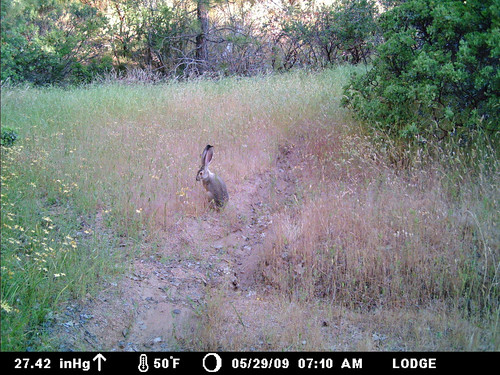
Black-tailed Jackrabbit - 5/29 7:12am
Stopping to smell the lilies...
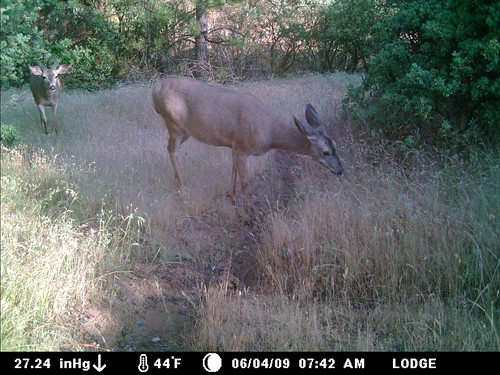
Doe & Buck - 6/4 7:42am
Bucks haven't gone up-country yet
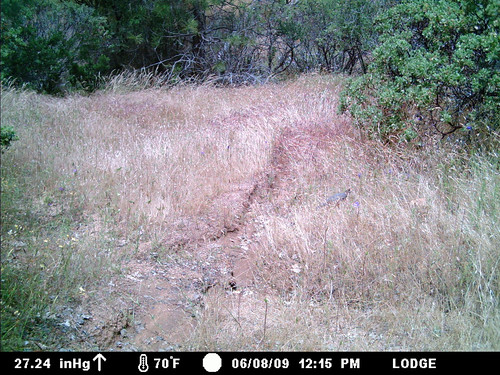
Ghost Quail - 6/8 12:15pm
Grasses are now tall and dry thus hiding the quail
Notes, analysis & color commentary:
There were 70 camera events over the 38 days:
| Misses (no visible animal) | 48 |
| Mule Deer | 10 |
| Black-tailed Jackrabbit | 4 |
| Black Bear | 2 |
| Wild Turkeys | 2 |
| Scrub Jay | 2 |
| House Cat | 1 |
| California Quail | 1 |
| Mountain Lion | 0 |
| Coyote | 0 |
| Bobcat | 0 |
| Gray Fox | 0 |
The Misses were all during the daytime on hot, 80+ degree Fahrenheit days, suggesting:
- an angle of transit for day/heat loving critters was crossed more quickly than my camera could wake and take (i.e., I placed it poorly for it's abilities)
- there's day/heat loving critters that are fast and easy to miss, such as quail & jackrabbits
- the camera is slower or more sensitive to false triggers on hot days
The Mule Deer are locals foraging the trails, which is why they are seen every few days. Didn't photograph any during the heat spell though.
The Cinnamon Black Bear came through twice, separated by 9 days, on 5/7 and 5/16. That's assuming it's the same bear. The size is about right, but the belly definitely seems bigger the second time through. If it's not the same bear (after a big meal), then it suggests they come through less often than once per month at this time of year, but there's a few of them (which we actually kinda already knew). Either way fits with a large territory size that they meander around based on food ripeness & availability.
The Wild Turkeys aren't a surprise. They're locals too that we see all the time. They don't forage in thick brush, so it's also not surprising they don't go up the hill often.
The Black-tailed Jackrabbit and California Quail shots are expected - they live in the manzanita in that corner, and are commonly out in the heat.
The lack of Bobcats, Coyotes and Gray Foxes surprises a bit. They can be sneaky, but I've seen their poop along this trail and caught them with the camera nearby, so they gotta be coming this way every-once-in-a-while. They most likely would have come at night though, and the night misses were few. Maybe they were busy elsewhere or prefer a different route.
There hasn't been a Mountain Lion around since last October, so not seeing one is also expected. With their large territory sizes it could take a while for one to move back into the area. Sans a neighboring cat moving here because the grass is greener, cougars stay with their Moms for 16-24 months, and Moms typically only have young every 2-3 years, so "homeless" cat availability might be limited. We'll see. Perhaps the newborn deer fawns will draw one...
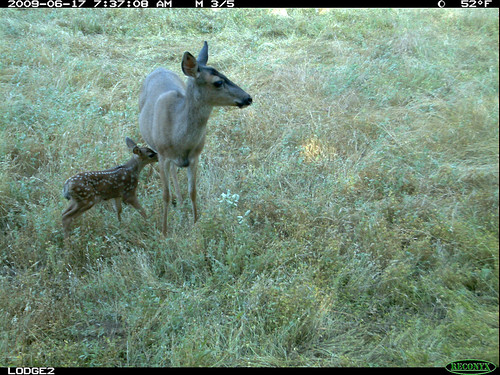
One of the newborn fawn twins w/ Mom in the garden - 6/17 7:37am
I might try the faster Reconyx trail camera up there too, just to see what might be causing the misses. It'll also give me a survey for a different time of year.
For my next fenceline survey, I have a camera trap on a gap in the north fence that I think the bears use. Perhaps we can learn more about how many there are and how often they come around these parts.
====
References:
- Wikipedia - American Black Bear
- Wikipedia - Cougar
- Wikipedia - Coyote
- Wikipedia - Bobcat
- Wikipedia - Gray Fox
- Wikipedia - Mule Deer
- Wikipedia - Black-tailed Jackrabbit
- Wikipedia - Wild Turkey
- Wikipedia - California Quail

Wow! You packed a lot of information into this piece in a mega-interesting style. Again,I learned a lot. Well done on the organization and analysis! Looking forward to the next entry.
ReplyDelete